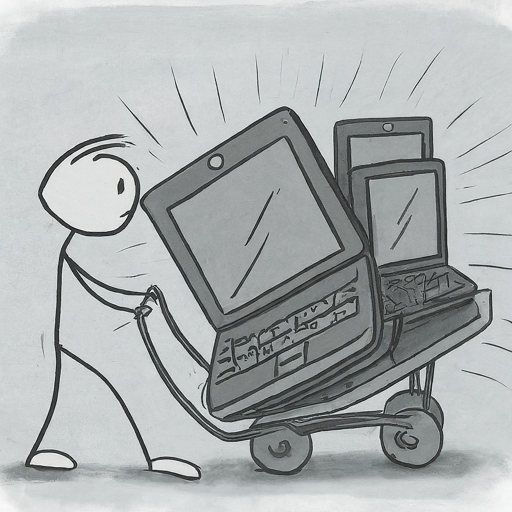Shuttling laptops in carts: foiled by lack of clear and united team vision

Estimated reading time: 4 minutes
My idea was for a local business to purchase dozens of laptops and shuttle them across different community schools within a neighborhood. At the time, laptops were not as affordable or as common as they are today, and community schools had a limited supply of desktop computers for computer science classes.
Inspiration and Model
In the early 2010s, IDEO, the product design consulting firm, was at the forefront of popular consciousness as a trendy and aspirational design company. Their non-profit arm, OpenIDEO, had recently started (in 2010) and was investing resources in becoming the go-to resource for aspiring and active social innovators. An OpenIDEO blog post detailed a new method for providing affordable computing and technological resources in a self-sustainable manner. The idea was that local institutions could “rent” equipment on a daily or weekly basis, while local business people could create a profitable business by leasing the same machines to multiple users. The goal was to pilot this concept in Kathmandu and eventually expand to other areas.
My Specific Idea
My idea was for a local business to purchase dozens of laptops and shuttle them across different community schools within a neighborhood. At the time, laptops were not as affordable or as common as they are today, and community schools had a limited supply of desktop computers for computer science classes. Several students would share the same computer during these classes. Our value proposition was this: schools would be able to provide one machine per child for classes at a cost-per-student-per-class comparable or lower to what they were currently spending on maintaining their existing machines. We would also provide instructors for the classes, if requested, at a cheaper cost than hiring full-time faculty.
Financial Sustainability
By increasing the utilization rate of the laptops, the initial investment for the machines could be recovered quickly. We estimated an 18-month timeframe for recovering a $20,000 USD initial investment, allowing for contingencies. Transportation costs would be reduced by working with local “clusters” of geographically proximate schools and using more affordable transportation methods. On weekends, the laptops could be made available in local libraries or public spaces for free computer science courses as a community service.
Initial Challenges and the Pilot Project
People I discussed the idea with doubted that local schools would buy in, believing the existing structure wouldn’t be open to such a novel concept. It was surprising then that we were able to secure a pilot project with six community schools located reasonably close to each other. I had a small team of volunteers who had agreed to donate their time. Funding was a challenge, but I had applied for several innovation grants and was confident the pilot project would go smoothly. By the end, I had invested nine months of work and was invested in the execution of the pilot.

Funding Disagreement Breakdown
The project ultimately fell apart due to a lack of complete agreement on funding. My local execution team believed schools were getting the entire service, including teachers, for free and funded by external aid agencies. Most “innovation projects” in Nepal are fully funded by grants from different aid agencies and INGOs, with no intention of being sustainable. From my perspective, the entire purpose of the project was to create a sustainable business model that would serve the community without relying on charity. While we were securing external funding for the initial round of devices, the goal was to use operational income to support the project’s operation and expand the program elsewhere. Even without relying on charity, as a business model, we had developed a way to provide the service cheaper than what community schools were already paying! However, my local execution partners believed aid agencies or “someone else” should fully shoulder all the project costs, and it wasn’t right to “make money” for a good cause. Without a team to run the project and due to my physical absence from Kathmandu, the idea never got off the ground and was aborted before the pilot project could begin. We were just about to order the laptops.
The Potential for a Sustainable Model
I still believe there’s a great opportunity to create a self-sustaining model by shuttling around relatively expensive equipment among schools (and potentially other institutions?) in Kathmandu. As the cost of the equipment would be shared across multiple parties, and the equipment utilization ratio would be high, the focus could be on improving the service aspect. Equipment such as fully assembled 3D printers, expensive microscopes, and other lab equipment could be great candidates for such a program.
